Solar-Blind UV Organic Mechanoluminescent Materials
Graphical Abstract
A new strategy to achieve solar-blind UV mechanoluminescent (ML) materials through strategically breaking the molecular conjugation and adjusting the packing mode. DPO3C and DPO4C exhibited solar-blind UV emission with the maxima at ca. 293 nm, with wide-range color-tunable ML emissions from 293 to 741 nm via host–guest doping. This study also paves the way for advancements in bright-field stress visualization.
Abstract
Organic mechanoluminescent (ML) materials have attracted intensive attention for their potential applications in real-time stress sensing and structural damage monitoring. To avoid interference from daylight or artificial lighting sources, the ML-based sensors can be only used in dark-field scenarios, which becomes the most serious limitation for their development. Herein, we proposed a new strategy that adjusts the ML spectra to the solar-blind ultraviolet (UV) region to address this challenge. By strategically breaking the molecular conjugation and adjusting the packing mode, a series of diphenylphosphine oxide derivatives were successfully designed. To our delight, the shortest ML emission, among all reported organic ML materials, with the maxima at ca. 293 nm (in solar-blind UV region) was achieved. Photophysical studies, single crystal analysis, and theoretical calculations were performed to investigate the solar-blind UV ML properties. Furthermore, wide-range color-tunable ML emissions spanning from 293 to 741 nm were achieved. Under various external stimuli such as stretching, folding, and vehicle impact in daylight, obvious ML signals could be directly recorded, and the quantitative relationship between the mechanical stimuli and the ML intensities was also studied. This work suggests a feasible strategy to realize solar-blind UV ML materials and makes bright-field environment ML sensors possible.
Conflict of Interests
The authors declare no conflict of interest.
Open Research
Data Availability Statement
The data that support the findings of this study are available from the corresponding author upon reasonable request.





